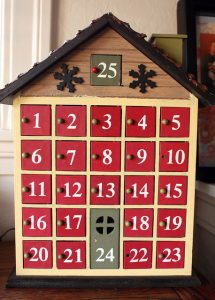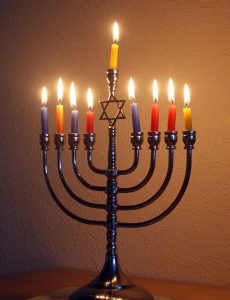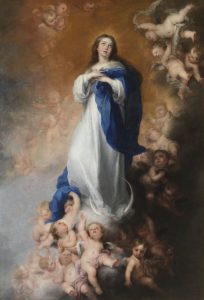December 2 - 24, 2018 - Advent
Advent is a part of the days leading up to the Christian celebration of Christmas. Advent marks the beginning of of the liturgical calendar, which is the church calendar. Advent starts four Sundays before Christmas, which is December 2 this year. The first half of the liturgical year focuses on the theme "Christ Our Light." This theme is embodied by the celebration of Christmas.
Advent happens during a time when, in the Northern Hemisphere, daylight is short. Some people have Advent wreaths. Candles are used to decorate these wreaths. The wreath contains evergreen branches (like pine), and has four candles, one for each week of advent. There are three purple candles, and one pink candle, which is lit on the third Sunday before Christmas. The pink candle symbolizes "Refreshment Sunday." This Sunday is less solemn than the others in tone. Sometimes there is a fifth candle, that is white, which is lit on Christmas day. These wreaths were used to provide light in the days up to Christmas, and to remind people that "Jesus is the Light of the World."
Advent and Lent were considered times to reflect on wrong-doings. Over the years, Advent became a more joyful time; as a part of the anticipation of the celebration of Jesus Christ's birth. Catholics may attend weekday mass and go to confession. All Christians may pray more, and try to practice more patience and tolerance. This helps some people prepare for Christmas; by focusing on the spiritual aspect of the season. Many people have advent calendars. These calendars have parts that open up, and there is one for each day in Advent. Each day they open up a part of the calendar for that day to receive a small gift or candy.
Learn more about Advent with these items:
Bach: Advent and Christmas Cantatas
December 3 -10, 2018 - Hanukkah
The Jews revolted. They were led by the priest Mattathias (also known as Matisyahu – and yes, that’s where the singer gets his name.) With Mattathias were his five sons, and a tiny army of Jews, known as the Maccabees. The revolt ended in the Jews’ reclaiming and rededicating their central temple three years after the invasion.
Counting the eight nights of Hanukkah is a great way to talk about numbers and addition with little kids. Hanukkah, A Counting Book in English, Hebrew, and Yiddish, is a great way to start the conversation.
For a look at various artistic interpretations of the traditional menorah, explore Five Centuries of Hanukkah Lamps From the Jewish Museum.
Five Centuries of Hanukkah Lamps From the Jewish Museum
And when you get sick of singing “I Had a Little Dreidel,” you can cue up Happy Joyous Hanukkah. In it, the Klezmatics use recently discovered Jewish lyrics penned by the legendary Woody Guthrie to create a new catalog of Hanukkah music.
Woody Guthrie's Happy Joyous Hanukkah
December 8, 2018 - Immaculate Conception of Mary
The Immaculate Conception of Mary is a Roman Catholic belief. It was controversial and debated heavily when it was introduced. Nevertheless, on December 8, 1854, Pope Pius IX, declared in the Ineffabilis Deus that the Immaculate Conception was revealed by God and that all Catholics should believe it. It is often thought that the holiday refers to the conception of Jesus Christ in Mary's womb. However, that is not the case, it actually refers to the Mary's conception. The term immaculate used to describe her conception is to suggest that she was born free of the stain of sin.
Mary was conceived the "normal way", unlike her son Jesus Christ. Those against the holiday have argued that the human nature of her conception proves that she could not possibly be free of sin and therefore, could not be immaculate. They say this is because the Bible says that all human beings are born sinners ever since the original sin committed by Adam and Eve in the Garden of Eden. Moreover, this belief is not backed up by Scripture as there is no direct proof of it in the Bible. It is unusual and frowned upon for any idea to be indoctrinated into the Catholic religion if it is not taught in Scripture.
Learn more about the Immaculate Conception of Mary with the books below.
Meditation Prayer on Mary Immaculate
The Immaculate Conception in Spanish Art
If there's a particular celebration you or someone you know participates in that we missed, let us know by leaving a comment on this post. Or, if you think we got something wrong, please also comment and let us know. We try to be as accurate as possible, but if there's a mistake, we want to correct it.





Add a comment to: The Origins and Practices of Holidays: Advent, Hanukkah, and the Immaculate Conception of Mary